Pharmacological modulation of repeated ethanol withdrawal-induced anxiety-like behavior differs in alcohol-preferring P and Sprague-Dawley rats
- PMID: 15894069
- PMCID: PMC2864140
- DOI: 10.1016/j.pbb.2005.03.006
Pharmacological modulation of repeated ethanol withdrawal-induced anxiety-like behavior differs in alcohol-preferring P and Sprague-Dawley rats
Abstract
Previous work with Sprague-Dawley (SD) rats indicated that subjecting these rats to multiple episodes of ethanol diet could provoke anxiety-like responses. Because alcohol-preferring P rats have been reported to have neurochemical alterations in many systems shown to modulate anxiety-like responses, P rats were compared to SD rats. Rats were subjected to one or three cycles of 5 days' exposure to 4.5% or 7% ethanol diet to assess anxiety-like behavior. The social interaction test was conducted 5 h after ethanol was removed. Other groups of P and SD rats were injected with flumazenil (5 mg/kg), a benzodiazepine (BZD) receptor antagonist, CP-154,526 (10 mg/kg), CRF1 receptor antagonist, SB243,213, a 5-HT2C receptor inverse agonist, or vehicle during the 1st and 2nd withdrawals but not the third. After a single 5-day cycle of ethanol exposure, SD rats did not exhibit a change in social interaction, but P rats exhibited a decrease after exposure to the 7% ethanol. Both strains of rats exhibited anxiety-like behavior following three cycles of exposure to ethanol and the concentration of ethanol in the diet did not influence the response. It was confirmed that flumazenil, CP-154,523, and SB243,213 had prophylactic effects on anxiety-like behavior in the SD rats. Neither flumazenil nor SB243,213 was as effective in the P rats, while the CRF1 receptor antagonist completely counteracted the reduced social interaction in repeatedly withdrawn P rats. A small study showed that buspirone, a 5-HT1A agonist, also had prophylactic effects in P rats. These findings show that alcohol-preferring P rats exhibit anxiety-like behavior more readily following exposure to ethanol-containing diets and that this behavior is counteracted more readily by pretreatment with a CRF1 receptor antagonist than with BZD or 5-HT2C receptor antagonists.
Figures
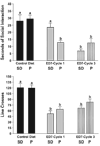
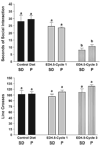

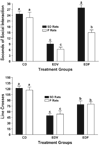
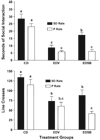

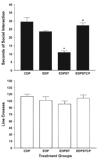
Similar articles
-
Drug challenges reveal differences in mediation of stress facilitation of voluntary alcohol drinking and withdrawal-induced anxiety in alcohol-preferring P rats.Alcohol Clin Exp Res. 2007 Sep;31(9):1473-81. doi: 10.1111/j.1530-0277.2007.00445.x. Epub 2007 Jul 11. Alcohol Clin Exp Res. 2007. PMID: 17624999 Free PMC article.
-
Modulation of ethanol withdrawal-induced anxiety-like behavior during later withdrawals by treatment of early withdrawals with benzodiazepine/gamma-aminobutyric acid ligands.Alcohol Clin Exp Res. 2005 Apr;29(4):553-63. doi: 10.1097/01.alc.0000158840.07475.97. Alcohol Clin Exp Res. 2005. PMID: 15834220 Free PMC article.
-
Sensitization, duration, and pharmacological blockade of anxiety-like behavior following repeated ethanol withdrawal in adolescent and adult rats.Alcohol Clin Exp Res. 2009 Mar;33(3):455-63. doi: 10.1111/j.1530-0277.2008.00856.x. Epub 2008 Dec 13. Alcohol Clin Exp Res. 2009. PMID: 19120055 Free PMC article.
-
A 5-HT1A agonist and a 5-HT2c antagonist reduce social interaction deficit induced by multiple ethanol withdrawals in rats.Psychopharmacology (Berl). 2003 Jun;167(4):344-52. doi: 10.1007/s00213-003-1425-y. Epub 2003 Apr 4. Psychopharmacology (Berl). 2003. PMID: 12677355 Free PMC article.
-
Modulation of multiple ethanol withdrawal-induced anxiety-like behavior by CRF and CRF1 receptors.Pharmacol Biochem Behav. 2004 Feb;77(2):405-13. doi: 10.1016/j.pbb.2003.11.010. Pharmacol Biochem Behav. 2004. PMID: 14751471 Free PMC article.
Cited by
-
Decreased immunoreactivity of the melanocortin neuropeptide alpha-melanocyte-stimulating hormone (alpha-MSH) after chronic ethanol exposure in Sprague-Dawley rats.Alcohol Clin Exp Res. 2008 Feb;32(2):266-76. doi: 10.1111/j.1530-0277.2007.00578.x. Epub 2007 Dec 21. Alcohol Clin Exp Res. 2008. PMID: 18162070 Free PMC article.
-
Dependence-induced increases in ethanol self-administration in mice are blocked by the CRF1 receptor antagonist antalarmin and by CRF1 receptor knockout.Pharmacol Biochem Behav. 2007 Apr;86(4):813-21. doi: 10.1016/j.pbb.2007.03.009. Epub 2007 Apr 3. Pharmacol Biochem Behav. 2007. PMID: 17482248 Free PMC article.
-
Persistent adaptation by chronic alcohol is facilitated by neuroimmune activation linked to stress and CRF.Alcohol. 2016 May;52:9-23. doi: 10.1016/j.alcohol.2016.01.005. Epub 2016 Feb 24. Alcohol. 2016. PMID: 27139233 Free PMC article. Review.
-
Effects of a stressor and corticotrophin releasing factor on ethanol deprivation-induced ethanol intake and anxiety-like behavior in alcohol-preferring P rats.Psychopharmacology (Berl). 2011 Nov;218(1):179-89. doi: 10.1007/s00213-011-2366-5. Epub 2011 Jun 4. Psychopharmacology (Berl). 2011. PMID: 21643675
-
Preclinical evidence implicating corticotropin-releasing factor signaling in ethanol consumption and neuroadaptation.Genes Brain Behav. 2015 Jan;14(1):98-135. doi: 10.1111/gbb.12189. Genes Brain Behav. 2015. PMID: 25565358 Free PMC article. Review.
References
-
- Andrews N, File SE, Fernandes C, Gonzalez LE, Barnes NM. Evidence that the median raphe nucleus–dorsal hippocampal pathway mediates diazepam withdrawal-induced anxiety. Psychopharmacology. 1997;130:228–234. - PubMed
-
- Breese GR, Knapp DK, Overstreet DH. Stress sensitization of ethanol withdrawal-induced reduction in social interaction: inhibition by CRF1 and benzodiazepine receptor antagonists and a 5-HT1A receptor agonist. Neuropsychopharmacology. 2004a;29:470–482. [online publication 10 July, 2003 at http://www.acnp.org/citations/Npp07100303159/default.pdf. - PMC - PubMed
-
- Costall B, Jones BJ, Kelly ME, Naylor RJ, Onaivi ES, Tyers MB. Ondansetron inhibits a behavioural consequence of withdrawing from drugs of abuse. Pharmacol Biochem Behav. 1990;36:339–344. - PubMed
-
- Dong E, Matsumoto K, Tohda M, Kaneko Y, Watanabe H. Diazepam binding inhibitor (DBI) gene expression in the brains of socially isolated and group-housed mice. Neurosci Res. 1999;33:171–177. - PubMed
Publication types
MeSH terms
Substances
Grants and funding
LinkOut - more resources
Full Text Sources
Medical
Miscellaneous

